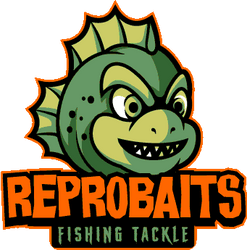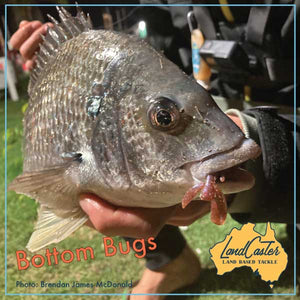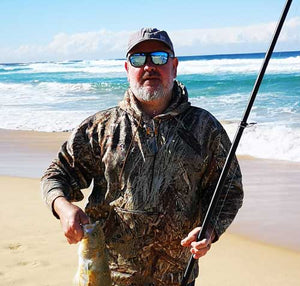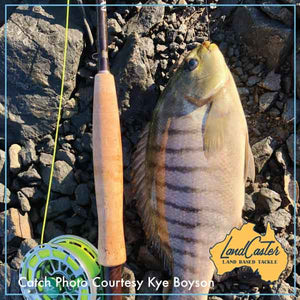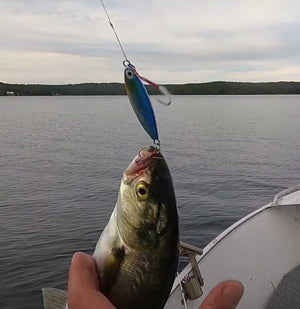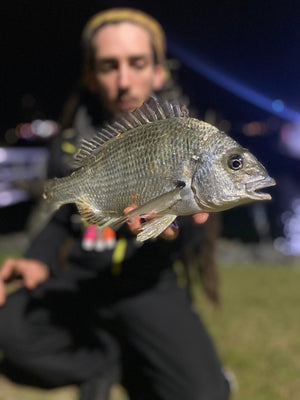Free Shipping Over $70

Catching Flathead: Tips and Tricks to Mastering the Art of Flathead
Catching Flathead: Tips and Tricks to Mastering the Art of Flathead Flathead fishing is an exciting activity that combines skill, patience, and the right gear. If you're looking to improve your catch rates and enjoy more successful outings, this guide will equip you with the knowledge and techniques specific to targeting one of Australia's most sought-after fish: the flathead.
Essential Gear for Flathead Fishing Choosing the right equipment is fundamental. For targeting flathead, opt for a balanced rod and reel setup. A graphite rod around 7 feet long, with a line rating of 2-4 kg or 2-5 kg, is ideal because it offers a perfect blend of sensitivity and strength. Pair this rod with a light spinning reel, such as a 2000 to 3000 model, to ensure smooth and long casts. Brands like Shimano offer reels like the Ci+ or Stradic, which are known for their lightweight and efficient design, enhancing the ease of your lure retrieval without unnecessary effort.
Line and Leader Considerations Your choice of line is crucial. While eight-strand braid lines offer smoother casting due to their thinner diameter, four-strand braids are generally more durable and provide better abrasion resistance, which is beneficial when fishing around structures like rocks or weed beds. For leaders, fluorocarbon is the top choice because it sinks quickly, allowing your lures to reach the desired depth faster, and it’s less visible underwater, decreasing the chances of spooking the fish.
Lure Selection Based on Conditions Lures are your main tool for attracting flathead. The choice of colour and type should be influenced by water clarity and conditions:
Enhance Your Lure with Scent Adding scent to your lures can make a significant difference, especially during tough conditions. Scents can replicate the amino acids of prey, making your lure more detectable and appealing. Reapply the scent every few casts or after catching a fish to maintain its effectiveness.
Jig Head Selection Choosing the right jig head depends on various factors like water depth, current strength, and wind conditions. It’s important to use jig heads that are heavy enough to maintain contact with the bottom but light enough to allow for natural movement. Brands like TT Fishing offer chemically sharpened hooks, which are ideal for ensuring maximum penetration and reducing wear.
Identifying Flathead Habitats Flatheads are ambush predators favouring areas where they can easily surprise prey. Look for spots with underwater structures such as drop-offs, submerged timber, and weed beds. These areas provide excellent hiding spots for flatheads and are typically rich in baitfish. Don't overlook sand flats as flathead love to hang around transition areas and depressions.
Mastering the Retrieve Varying your retrieve can be crucial in enticing flatheads. Experiment with the length of your pauses and the speed of your hops to see what the fish responds to best on any given day. A mix of slow and fast retrieves, matched with natural pauses, can mimic vulnerable prey and trigger aggressive strikes from flathead. If you aren't having much luck with one method try several methods until you find one that is working. If you go out with a mate use two different tactics. If one hooks up with more fish then swap over to what is working.
Understand Flathead and Increase Your Catch Fishing for flathead is not just about casting a line; it’s about understanding the fish’s habits, the environment, and how to effectively use your gear. With the right approach and a bit of practice, you’ll find yourself landing flatheads more consistently. Remember, every fishing trip is an opportunity to learn and grow as an angler. So, gear up, hit the water, and enjoy the thrill of the catch.
Essential Gear for Flathead Fishing Choosing the right equipment is fundamental. For targeting flathead, opt for a balanced rod and reel setup. A graphite rod around 7 feet long, with a line rating of 2-4 kg or 2-5 kg, is ideal because it offers a perfect blend of sensitivity and strength. Pair this rod with a light spinning reel, such as a 2000 to 3000 model, to ensure smooth and long casts. Brands like Shimano offer reels like the Ci+ or Stradic, which are known for their lightweight and efficient design, enhancing the ease of your lure retrieval without unnecessary effort.
Line and Leader Considerations Your choice of line is crucial. While eight-strand braid lines offer smoother casting due to their thinner diameter, four-strand braids are generally more durable and provide better abrasion resistance, which is beneficial when fishing around structures like rocks or weed beds. For leaders, fluorocarbon is the top choice because it sinks quickly, allowing your lures to reach the desired depth faster, and it’s less visible underwater, decreasing the chances of spooking the fish.
Lure Selection Based on Conditions Lures are your main tool for attracting flathead. The choice of colour and type should be influenced by water clarity and conditions:
- Murky Waters: Use dark or vibrantly coloured lures to create a silhouette or provoke a reaction. Grubs and paddle tails are effective as they produce significant vibrations.
- Clear Waters: Opt for lures that mimic the natural appearance of local baitfish, such as silver or white. The subtle action of a grub tail can appear more natural, resembling crustaceans and worms which flatheads prey on.
Enhance Your Lure with Scent Adding scent to your lures can make a significant difference, especially during tough conditions. Scents can replicate the amino acids of prey, making your lure more detectable and appealing. Reapply the scent every few casts or after catching a fish to maintain its effectiveness.
Jig Head Selection Choosing the right jig head depends on various factors like water depth, current strength, and wind conditions. It’s important to use jig heads that are heavy enough to maintain contact with the bottom but light enough to allow for natural movement. Brands like TT Fishing offer chemically sharpened hooks, which are ideal for ensuring maximum penetration and reducing wear.
Identifying Flathead Habitats Flatheads are ambush predators favouring areas where they can easily surprise prey. Look for spots with underwater structures such as drop-offs, submerged timber, and weed beds. These areas provide excellent hiding spots for flatheads and are typically rich in baitfish. Don't overlook sand flats as flathead love to hang around transition areas and depressions.
Mastering the Retrieve Varying your retrieve can be crucial in enticing flatheads. Experiment with the length of your pauses and the speed of your hops to see what the fish responds to best on any given day. A mix of slow and fast retrieves, matched with natural pauses, can mimic vulnerable prey and trigger aggressive strikes from flathead. If you aren't having much luck with one method try several methods until you find one that is working. If you go out with a mate use two different tactics. If one hooks up with more fish then swap over to what is working.
Understand Flathead and Increase Your Catch Fishing for flathead is not just about casting a line; it’s about understanding the fish’s habits, the environment, and how to effectively use your gear. With the right approach and a bit of practice, you’ll find yourself landing flatheads more consistently. Remember, every fishing trip is an opportunity to learn and grow as an angler. So, gear up, hit the water, and enjoy the thrill of the catch.
